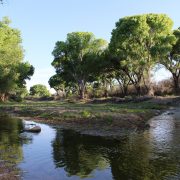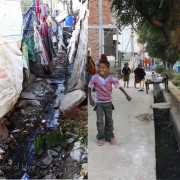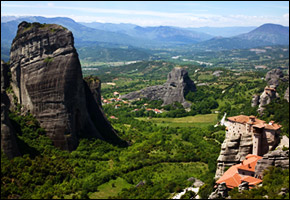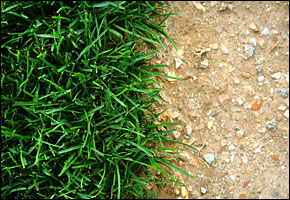Global warming to increase unpredictable weather, impacts on water, Cooley says in Congressional testimony

WASHINGTON – Congressional testimony July 10 said that global warming is likely to increase pressure on existing water resources and cause extreme events such as floods and droughts, as well as a rise in sea-levels. During the congressional committee hearing, Heather Cooley, senior research associate at the Pacific Institute, described what to expect and how policy makers and the public can reduce risks from myriad climate impacts on water.
Full text of Cooley’s testimony to the United States Congress Select Committee on Energy Independence and Global Warming:
For the Hearing on Global Warming Effects on Extreme Weather
July 10, 2008
My testimony today addresses the rising risk of extreme weather-related events as a result of climatic changes and their impact on water resources, with a focus on the western United States. In the short time available, let me provide a summary overview. I have submitted more detailed supplementary materials for your review.
The United States already faces growing pressures on existing water resources due to increases in population, industrial and agricultural water demand, and rapid development in semi-arid and arid regions. Based on a sizable and growing body of scientific analysis, it now seems highly likely that climate change will vastly increase those pressures. Of special concern is an expected increased risk of extreme events, such as floods, droughts, and heat waves. I will address what we can expect, and what policymakers and the public should begin to do to reduce the risks to life and property that we now expect.
Floods and droughts are among the most common and damaging of all natural hazards and much of the existing water infrastructure in the United States was built to lessen these hazards. Since 1903, floods have killed an average of 93 people annually in the United States, but single extreme events can kill hundreds or even thousands. Droughts also can lead to illnesses and deaths, but are more closely associated with economic damages. Direct economic losses from floods and droughts are high, averaging US$11.5 billion annually in direct losses; again, individual extreme events can be much higher1. Hurricane Katrina, for example, is estimated to have led to direct economic losses of $100 billion to $150 billion, of which about 30% is attributed to flood losses. If indirect damages and losses associated with floods and droughts, such as loss of business and personal income, reductions in property value, etc., are included, these estimates would increase substantially.
Floods and droughts have dominated headlines in papers across the United States in recent months. Floods along the Mississippi River and its tributaries have devastated communities throughout the Midwest. Drought conditions are prevailing across large parts of the United States. As of July 2008, moderate-to-exceptionally severe droughts are affecting 35% of the western U.S.; 40% of the South; 17% of the High Plains; and 59% of the Southeast. Overall, nearly 30% of the contiguous U.S. is suffering moderate–to-exceptional drought.2 In California alone, drought conditions have spawned nearly 2000 fires since late June in what may turn out to be one of the worst fire seasons on record.
Floods and droughts are, of course, a natural part of the climate system. Growing and convincing scientific evidence, however, indicates that increases in greenhouse gases are causing large, systemic change to our climate with implications for the intensity and frequency of hydrologic extremes, i.e., floods and droughts. While scientists are reluctant to attribute individual events like those experienced in 2008 specifically to climate change, long-term records and trends increasingly suggest that we are essentially “loading the dice” and increasing the probability that these types of events will increase
in frequency and intensity.
Climate Change: What Can We Expect for Floods, Droughts, and Sea-Level Rise
The best climate science notes: “Warming of the climate system is unequivocal, as is now evident from observations of increases in global average air and ocean temperatures, widespread melting of snow and ice, and rising global average sea level.”3 Atmospheric climate models indicate that global warming will induce significant changes to global water resources and coastal ocean conditions during the next century; average surface air temperatures are projected to rise by 1.1°C to 6.4°C; sea level is expected to rise at least 18 cm to 59 cm; and average precipitation is expected to increase due to higher evaporation rates caused by warmer temperatures. These changes in averages, however, will also be accompanied by changes in extremes.
As noted in the 2000 National Water Assessment prepared for Congress and the President under the 1990 Global Change Research Act (PL 101-606), “[w]hile many factors of concern are affected by such average conditions, some of the most important impacts will result, not from changes in averages, but from changes in local extremes.”
As models have improved in recent years, scientists are increasingly investigating the risks of these extreme events in greater detail. Over the next 100 years, most climate models are in agreement that warmer temperatures will intensify the hydrologic cycle, leading to greater climate variability and an increase in the risk of both floods and droughts. Throughout the northern middle and high latitudes, warmer temperatures are projected to increase summer dryness and winter wetness.4 Thus the frequency and intensity of both floods and droughts are expected to increase – the worst of all possible worlds. As an example, more frequent or larger extreme events can change what we think of as a 1-in-100-year event (something that has a 1% chance of occurring in any year) could become a 1-in-10-year event (something that has a 10% chance of occurring in any year).
An example of this can be seen in research and observations in the western United States. For nearly two decades now, climate research has pointed to serious changes in regions where snowfall and snowmelt are critical for water supply. Models indicate that warmer temperatures will raise the snowline in mountainous regions, causing more precipitation to fall as rain rather than snow, thereby increasing the likelihood of winter floods. To make matters worse, the higher temperatures mean that what does fall as snow will melt faster and earlier. Recent observations suggest that these changes are beginning to occur.
What does this mean? Even under optimistic scenarios of climate change, all the climate models suggest that winter runoff will rise – threatening more floods, and summer runoff will decrease – threatening agricultural production and water supply for cities. By the end of this century, scientists forecast that as much as 70% of California’s snowpack will be lost due to warming (Figure 1). Similar kinds of changes are likely for the Rocky Mountain States and the Pacific Northwest.
Figure 1. The loss of California snowpack under two climate scenarios by mid- and late-century.

As the country saw so dramatically with Hurricane Katrina, extreme flooding can also result from storms in coastal areas vulnerable to sea-level rise caused by climate change. Again, all climate models show dramatic increases in sea level over the coming decades, putting lives and property at risk from coastal storms and storm surges. For example, millions of people and hundreds of billions of dollars of property are exposed to these risks along the West coast of the United States.. As sea level rises, storm surges the number of people and property at risk will also rise. California’s Bay Conservation and Development Commission recently completed maps showing areas around the San Francisco Bay that are at risk from a 1-meter rise in sea level. As shown in Figure 2, valuable infrastructure, including the Oakland and San Francisco airports, power plants, highways, railroads, industrial sites, and residential property along the margins of the San Francisco Bay are vulnerable to sea level rise. An early 1990 study by Gleick and Maurer, now being updated, suggests that property valued at more than $40 billion was at risk in this area – a figure that is now thought to be much higher.5
Figure 2: Map of Inundated Areas Associated with a 1-Meter Sea Level Rise.

Note: This map shows inundated areas but do not capture areas at risk of flooding during storms or other high water events. Work currently underway at the Pacific Institute will provide more detailed maps of flood damage along the entire California coast.
Climate Change will Alter Both Water Supply and Quality
Changing climate conditions will also affect the supply of and demand for water resources. The Intergovernmental Panel on Climate Change’s (IPCC) Fourth Assessment Report notes that climate change will lead to “changes in all components of the freshwater system.” Indeed, all of the IPCC reports conclude that freshwater systems are among the most vulnerable sectors. Climate change will have a significant impact on freshwater resources, affecting availability, timing, reliability, and quality. Below we describe some of the impacts associated specifically with floods and droughts.
One of the most obvious impacts of drought is a reduction in water supply, which is generally a temporary phenomenon but can become permanent. Over-pumping of groundwater, for example, can cause an aquifer to collapse, devastating regions and farms production that rely on groundwater as a primary supply. Drought can also compromise water quality by increasing the salinity and temperature of water bodies and reducing oxygen levels. In addition, drought can lead to higher water-pollution levels, as less water in rivers, streams, and lakes means that there is less water available to dilute wastewater effluent. These water-quality problems can exacerbate water-supply problems.
Flooding can also affect both water supply and quality. It can cause toxic spills and leaks that contaminate riverine systems and expose buried contaminates and redistribute them along the river. More intense precipitation events can increase erosions rates and wash more pollutants and toxins into waterways. Storm surges or levee breaks can induce saltwater intrusion in coastal areas, contaminating freshwater ecosystems. In some areas, such as the Sacramento-San Joaquin Delta in California, saltwater intrusion can contaminate the water supply for a large segment of the population.
What Can We Do to Reduce the Risks of Extreme Events from Climate Change?
Adapting to a Changing World
Impacts associated with climate change are now unavoidable. The Earth’s energy system is out of balance and even if we stop emitting greenhouse gases today, the Earth’s climate will continue to change. Because we have already committed to a certain degree of climate change and emissions continue unabated, adaptation must be a central element of all climate-change policy. The IPCC defines adaptation as “initiatives and measures to reduce the vulnerability of natural and human systems against actual and expected climate-change effects.”
A key element in any climate adaptation strategy is to avoid taking rigid, expensive, and irreversible actions in climate-sensitive areas that worsen our vulnerability and ultimately increase the long-term costs to society. Given remaining uncertainties associated with climate change, some planners support policies that provide social, economic, and environmental benefits regardless of climate change impacts, referred to as “no regret” policies. Some of these “no regret” adaptation options include a greater emphasis on water efficiency, improved weather-monitoring efforts, expanding water supply options, and better planning and preparedness for floods and droughts. Below, I describe some of these “no regret” options.
Smarter Floodplain Management Can Reduce Deaths and Damages
Traditional floodplain management has typically relied upon controlling a river via large-scale structural measures, such as dams, levees, and diversions. Levees and other structural methods, however, have a number of disadvantages as seen in the recent Mississippi floods. In addition to isolating the river and eliminating important ecosystem functions and processes, structural methods tend to increase vulnerability to the hazard by encouraging development in flood-prone areas and giving those who live behind the structure a false sense of security. For this reason, recommendations after flood events now consistently call for less reliance on strict and rigid structures in favor of smarter floodplain management. In addition to structural mitigation measures, traditional flood management has also relied on disaster response such as evacuations and relief aid, which can encourage redevelopment in unsafe locations as well, thereby increasing the long-term risk associated with these events.
The 1994 Galloway report, however, strongly asserts that a new approach is needed; one based on “avoiding the risks of the floodplain; minimizing the impact of those risks when they cannot be avoided; mitigating the impacts of damages when they occur; and accomplishing the above in a manner that concurrently protects and enhances the natural environment.”6 Smart land-use management can effectively reduce the risk of floods. This approach could include armoring existing urban centers whose existence is tied to the river; relocating high-risk businesses and homes; placing parks, wildlife, and recreation areas in flood-prone areas; and providing for upstream flooding to protect downstream areas. In addition, proper land-use management can increase the benefits of floods; floodwaters, and the sediments they contain, providing an important resource for maintaining agricultural productivity. For example, California’s Yolo Bypass was established as a flood conveyance channel around communities in the Sacramento River watershed in California. While the Bypass is an effective flood control method, it also provides a number of other benefits, including essential upland and wetland habitat for wildlife, as well as productive agricultural land for a variety of farm uses.
Although not typically considered an element of land-use management, leaving certain elements of the natural environment in place may help reduce the risk of flood. Wetlands, for example, can absorb large volumes of water and release the water after the flood peak has receded. Wetlands, as well as mangroves, can also absorb some of the energy associated with storms and minimize coastal inundation.
Water Conservation and Efficiency Offer Enormous Potential for Reducing Pressure on Water Supply
Improving the productivity of water use is a particularly attractive adaptation option. The terms “water conservation and efficiency” refer to actions that permit us to reduce the amount of water needed to do the things we want: to grow food, produce industrial goods and service, clean our cloths or homes, and remove wastes.. While some still think of “conservation” as the same as “deprivation” — shorter showers, dirty cars, and brown lawns — those kinds of temporary actions are only adopted during a drought or some other water-supply emergency. But comprehensive improvements in the efficiency of water use are permanent and largely cost-effective: they typically result from the application of well-known and widely used technologies, such as digital x-ray machines, drip irrigation systems, modern cooling systems, low-flow toilets, and front-loading clothes washers.
These technologies have already contributed to significant improvements in the efficiency of national water use. Over the past 25 years, total water use has declined while the population and economy have grown (Figure 3), supporting the notion that water conservation and efficiency can reduce water use while helping the economy. As a result of past efforts, per-capita water use has declined from a high of 1,950 gallons per person per day in 1977 to 1,480 gallons per person per day in 2000 (Figure 4). Even in the West, where concerns about water-supply constraints have long been a reality, water use remains wasteful and the potential for further improvements in efficiency is tremendous. The Pacific Institute’s 2003 study, “Waste Not, Want Not,” provides a comprehensive statewide analysis of the conservation potential in California’s urban sector. This study finds that existing, cost-effective technologies and policies can reduce current residential, industrial, and commercial water demand by more than 30 percent.7 A more recent study, “California Water 2030,” concludes that the state as a whole could reduce water use in urban and agricultural sectors by 20% overall with existing technologies, even with a growing population and economy.8
Figure 3: U.S. Total Water Use and Gross National Product, 1900-2000

Figure 4: Total Per Capita Water Use in the United States, 1900-2000
Substantial savings are available from the agricultural sector as well. More than 40% of all crops grown in the western United States are still grown with inefficient flood irrigation systems. Studies have shown that installing efficient irrigation technologies, such as drip system or sprinklers, can reduce water use and increase agricultural yield. Given that the agricultural sector uses, on average, 85% of the West’s water supply, even small efficiency improvements can produce tremendous water savings. Additional water savings are possible if farmers continue the trend of moving away from water-intensive crops like cotton, pasture, rice, and alfalfa in favor of more valuable, less water-intensive crops like fruits, vegetables, and nuts.
Recycled Water Offers New Supply for Some Uses
Another new source of water is the collection, treatment, and reuse of wastewater. In California alone, an estimated 500,000 acre-feet (163 billion gallons) of water are recycled and reused each year for a wide range of purposes, from agricultural and landscape irrigation to power-plant cooling and groundwater recharge. Some communities are already beginning to tap this resource. For example, the Irvine Ranch Water District, in Southern California, meets nearly 20% of its total demand with recycled water. A new residential community in Ventura County, California has decided to use recycled water for all of its landscaping needs at costs far below the cost of new surface storage. This suggests that significant opportunities exist to increase recycling and reuse throughout the West, effectively lessening the need to identify and develop new water supplies and reducing our vulnerability to climate change impacts.
Conjunctive Use of Surface and Groundwater Offers New Storage Possibilities
Surface water and groundwater are hydrologically linked. “Conjunctive use” takes advantage of this connection by storing excess surface water, including storm water, in groundwater aquifers for later use in dry years. This option, already being implemented in parts of the West, has a number of important benefits, including reducing the risk of floods, improving water-supply reliability and flexibility, reducing land subsidence, and minimizing the impacts of urban runoff on local streams and the marine environment.
While Adaptation is Critical, There are Also Important Mitigation Options
While we must begin planning to adapt to those climate impacts that are unavoidable, we must also work to try to avoid severe climate impacts to which we cannot adapt. The good news is that the strong connections between water and energy offer us some unique opportunities to both reduce greenhouse gas emissions and to use water more sustainably.
Capturing, treating, transporting, and using water require large amounts of energy. This is particularly true in the West, where water supplies and population centers are often separated by hundreds of miles, requiring a tremendous amount of infrastructure to move water from where it is available to where it is needed. In California, for example, an estimated 19% of electricity use, 32% of all natural gas consumption, and 88 million gallons of diesel fuel consumption are water-related.9 Thus, a key new strategy focused on saving water through conservation and efficiency improvements can also save energy. Furthermore, a recent analysis by the California Energy Commission found that energy can be saved through water conservation at lower cost than through traditional energy efficiency measures.
The production of energy also requires water – often vast amounts of water for cooling traditional fossil fuel and nuclear power plants. When water is in short supply, energy production can be constrained, and there are concerns that climatic changes will threaten energy production because of the increased risk of drought. This is already a reality in parts of the United States (see headlines, below).
- “Drought Could Force Nuke-Plant Shutdowns”
The Associated Press, January 2008 - “Sinking Water and Rising Tensions”
EnergyBiz Insider, December 2007 - “Stricter Standards Apply to Coal Plant, Judge Rules; Activists Want Cooling Towers for Oak Creek”
Milwaukee Journal Sentinel, November 2007 - “Journal-Constitution Opposes Coal-Based Plant, Citing Water Shortage”
The Atlanta Journal-Constitution, October 2007 - “Maryland County Denies Cooling Water to Proposed Power Plant”
E-Water News Weekly, October 2007 - “Water Woes Loom as Thirsty Generators Face Climate Change”
Greenwire, September 2007
But not all energy systems are equally demanding of water: many renewable energy systems require very little water (see Figure 5). As U.S. water supply becomes increasingly scarce as a result of climate change and continued economic and population growth, these low-water-using energy sources will become even more attractive. Thus conversion to renewable energy sources, such as wind and solar, can help reduce our vulnerability to water supply constraints on energy production and reduce greenhouse gas emissions at the same time.
Figure 5: Consumptive Use of Water By Various Energy Technologies
Recommendations
Let me conclude with a set of recommendations, several of which would benefit from legislative action.
- Existing state, federal, and local water systems should be tested under a range of potential future climate conditions to see how they respond and the extent to which they are vulnerable to expected changes. Water managers must re-evaluate engineering designs, reservoir operating rules, contingency plans, and water-allocation policies.
- All new water infrastructure must be designed and built incorporating climate change over the expected life of the project, including levees, reservoirs, and constructed and restored wetlands.
- All water-management decisions must take into account their energy and greenhouse-gas implications, with a focus on identifying actions that can both improve water management and efficiency and reduce energy use and emissions.
- Water agencies should partner with other agencies and authorities to seek combined solutions to water, energy, and greenhouse-gas problems.
- The management of water resources is spread among a number of federal and state agencies. The Environmental Protection Agency, for example, oversees water quality, while the United States Geological Survey monitors water use. Dams are operated by the Army Corps of Engineers in some locations and the Bureau of Reclamation in others. Better coordination is needed among these agencies to ensure effective management of this essential resource.
- The last National Water Assessment of the impacts of climate change on the country was completed in 2000. This assessment should be updated in light of extensive new research on water and climate change.
- A new National Water Commission, as proposed in legislation now pending (HR 135), has the potential to offer new recommendations for better water management in the nation as a whole. The risks of climate change must be included as a factor for this Commission to address.
Source : Pacific Institute
Download the PDF of her testimony.
2. Data from the United States Drought Monitor
3. Bernstein, L. et al. 2007. Summary for Policymakers. Climate Change 2007: Synthesis Report. Intergovernmental Panel on Climate Change Fourth Assessment Report.
4. Meehl, G.A., T.F. Stocker, W.D. Collins, P. Friedlingstein, A.T. Gaye, J.M. Gregory, A. Kitoh, R. Knutti, J.M. Murphy, A. Noda, S.C.B. Raper,I.G. Watterson, A.J. Weaver and Z.-C. Zhao, 2007: Global Climate Projections. In: Climate Change 2007: The Physical Science Basis. Contribution of Working Group I to the Fourth Assessment Report of the Intergovernmental Panel on Climate Change [Solomon, S.,D. Qin, M. Manning, Z. Chen, M. Marquis, K.B. Averyt, M. Tignor and H.L. Miller (eds.)]. Cambridge University Press, Cambridge, United Kingdom and New York, NY, USA.
5. Gleick, P.H. and E.P. Maurer. 1990. “Assessing the costs of adapting to sea-level rise: A case study of San Francisco Bay.” Pacific Institute for Studies in Development, Environment, and Security, Berkeley, California and the Stockholm Environment Institute, Stockholm, Sweden. 57 pp. with 2 maps.
6. Interagency Floodplain Management Review Committee. 1994. Sharing the Challenge: Floodplain
Management into the 21st Century. Administration Floodplain Management Task Force.
7. See http://www.pacinst.org/reports/urban_usage/
8. See http://www.pacinst.org/reports/california_water_2030/index.htm
9. To put these numbers in perspective, consider that leaving the hot water running for 5 minutes uses as much energy as operating a 60-W light bulb for 14 hours.
Circle of Blue’s east coast correspondent based in New York. He specializes on water conflict and the water-food-energy nexus. He previously worked as a political risk analyst covering equatorial Africa’s energy sector, and sustainable development in sub-Saharan Africa. Contact: Cody.Pope@circleofblue.org








Floods and droughts have dominated headlines in papers across the United States in recent months. Floods along the Mississippi River and its tributaries have devastated communities throughout the Midwest. Drought conditions are prevailing across large parts of the United States. As of July 2008,